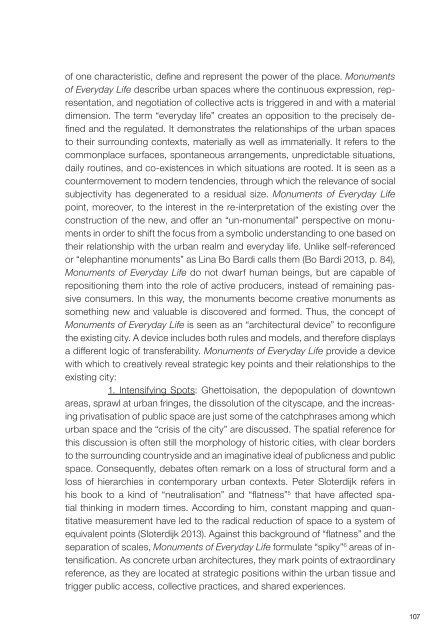Creative Heritage
ISBN 978-3-86859-532-1 https://www.jovis.de/de/buecher/product/creative-heritage.html
ISBN 978-3-86859-532-1
https://www.jovis.de/de/buecher/product/creative-heritage.html
Create successful ePaper yourself
Turn your PDF publications into a flip-book with our unique Google optimized e-Paper software.
of one characteristic, define and represent the power of the place. Monuments<br />
of Everyday Life describe urban spaces where the continuous expression, representation,<br />
and negotiation of collective acts is triggered in and with a material<br />
dimension. The term “everyday life” creates an opposition to the precisely defined<br />
and the regulated. It demonstrates the relationships of the urban spaces<br />
to their surrounding contexts, materially as well as immaterially. It refers to the<br />
commonplace surfaces, spontaneous arrangements, unpredictable situations,<br />
daily routines, and co-existences in which situations are rooted. It is seen as a<br />
countermovement to modern tendencies, through which the relevance of social<br />
subjectivity has degenerated to a residual size. Monuments of Everyday Life<br />
point, moreover, to the interest in the re-interpretation of the existing over the<br />
construction of the new, and offer an “un-monumental” perspective on monuments<br />
in order to shift the focus from a symbolic understanding to one based on<br />
their relationship with the urban realm and everyday life. Unlike self-referenced<br />
or “elephantine monuments” as Lina Bo Bardi calls them (Bo Bardi 2013, p. 84),<br />
Monuments of Everyday Life do not dwarf human beings, but are capable of<br />
repositioning them into the role of active producers, instead of remaining passive<br />
consumers. In this way, the monuments become creative monuments as<br />
something new and valuable is discovered and formed. Thus, the concept of<br />
Monuments of Everyday Life is seen as an “architectural device” to reconfigure<br />
the existing city. A device includes both rules and models, and therefore displays<br />
a different logic of transferability. Monuments of Everyday Life provide a device<br />
with which to creatively reveal strategic key points and their relationships to the<br />
existing city:<br />
1. Intensifying Spots: Ghettoisation, the depopulation of downtown<br />
areas, sprawl at urban fringes, the dissolution of the cityscape, and the increasing<br />
privatisation of public space are just some of the catchphrases among which<br />
urban space and the “crisis of the city” are discussed. The spatial reference for<br />
this discussion is often still the morphology of historic cities, with clear borders<br />
to the surrounding countryside and an imaginative ideal of publicness and public<br />
space. Consequently, debates often remark on a loss of structural form and a<br />
loss of hierarchies in contemporary urban contexts. Peter Sloterdijk refers in<br />
his book to a kind of “neutralisation” and “flatness” 5 that have affected spatial<br />
thinking in modern times. According to him, constant mapping and quantitative<br />
measurement have led to the radical reduction of space to a system of<br />
equivalent points (Sloterdijk 2013). Against this background of “flatness” and the<br />
separation of scales, Monuments of Everyday Life formulate “spiky” 6 areas of intensification.<br />
As concrete urban architectures, they mark points of extraordinary<br />
reference, as they are located at strategic positions within the urban tissue and<br />
trigger public access, collective practices, and shared experiences.<br />
107


















